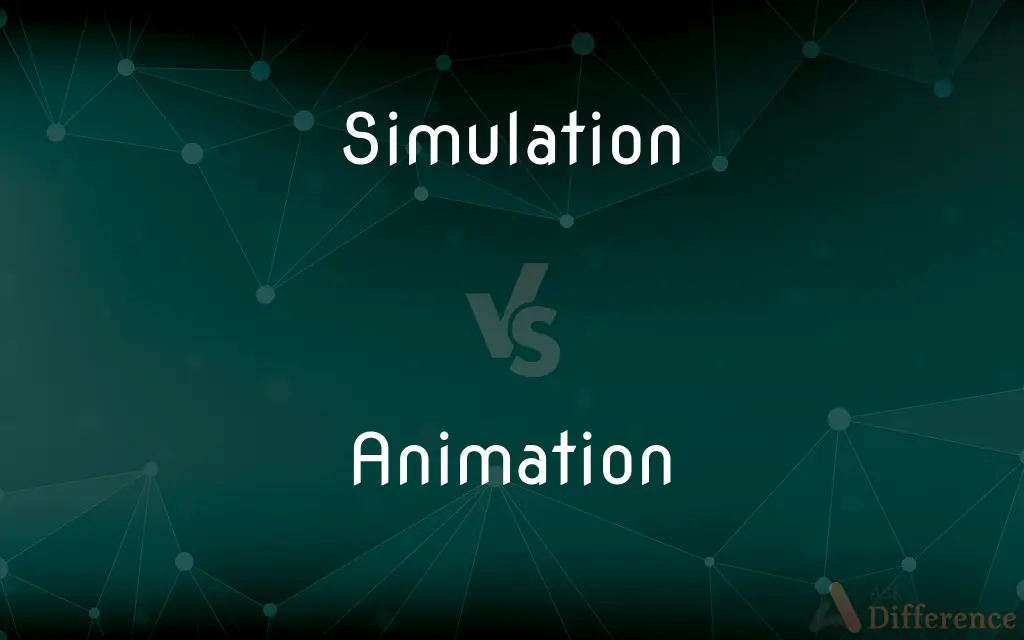Simulation vs. Animation — What's the Difference?
By Urooj Arif & Maham Liaqat — Updated on April 27, 2024
Simulation models real-world processes or systems over time for analysis, while animation creates moving images for visual storytelling.

Difference Between Simulation and Animation
Table of Contents
ADVERTISEMENT
Key Differences
Simulation is used primarily in scientific and technical fields to mimic real-world processes, enabling prediction and analysis of complex systems. While animation focuses on creating visually appealing sequences that can tell stories or explain concepts in a more engaging way.
In simulations, accuracy and adherence to real-world physics or conditions are crucial as they impact the validity of the results. Whereas in animation, artistic expression often takes precedence over strict realism, allowing for exaggerated motions and stylized visuals to enhance viewer engagement.
Technologically, simulations require robust computational models and are often run on powerful computers to handle complex calculations. On the other hand, animation can be produced with a wide range of tools, from simple software for basic cartoons to advanced systems for 3D movie production.
Simulations are valuable for training purposes, such as in flight simulators for pilots, where realistic scenarios help improve skills without real-world risks. Whereas animations are widely used in entertainment, from movies and video games to educational videos, where the goal is often to entertain or inform.
The development process of a simulation involves creating a mathematical model that can accurately represent the system being studied or replicated. While the creation of an animation involves storyboard development, character design, and sequential frame rendering to bring visual stories to life.
ADVERTISEMENT
Comparison Chart
Primary Use
Analysis and prediction of real-world systems
Creation of moving images for storytelling
Focus on Realism
High, aims for accuracy
Variable, often stylized
Key Tools
Computational models, simulation software
Animation software, rendering tools
Common Industries
Engineering, aviation, healthcare
Film, video games, television
Output
Often data and scenario outcomes
Visual content, films, video sequences
Compare with Definitions
Simulation
A method to model the behavior of a system using a set of mathematical formulas.
A weather simulation predicts tomorrow's storm by calculating atmospheric conditions.
Animation
A technique in film and video production to bring illustrations to life.
Animation of mythical creatures is common in fantasy films.
Simulation
A training technique using realistic scenarios in a controlled environment.
Pilots use flight simulations for hours before flying an actual plane.
Animation
The process of making static images move.
Animation studios create character motions frame by frame for movies.
Simulation
A tool for analysis used in engineering to test new designs.
Engineers simulate bridge loads to ensure safety under real-world stresses.
Animation
A tool for education, explaining complex subjects simply.
Animation is used in schools to demonstrate scientific concepts like photosynthesis.
Simulation
A virtual representation used in science for hypothesis testing.
Scientists simulate molecular interactions to study new drugs.
Animation
A form of artistic expression in digital media.
Artists create short animations to express emotions and stories.
Simulation
A method for risk assessment in financial markets.
Financial analysts simulate market crashes to test investment strategies.
Animation
A component of user interface design in software and websites.
Web designers use animations to enhance the user experience by making transitions smoother.
Simulation
A simulation is the imitation of the operation of a real-world process or system over time. Simulations require the use of models; the model represents the key characteristics or behaviors of the selected system or process, whereas the simulation represents the evolution of the model over time.
Animation
Animation is a method in which figures are manipulated to appear as moving images. In traditional animation, images are drawn or painted by hand on transparent celluloid sheets to be photographed and exhibited on film.
Simulation
The act or process of simulating.
Animation
The act, process, or result of imparting life, interest, spirit, motion, or activity.
Simulation
An imitation; a sham.
Animation
The quality or condition of being alive, active, spirited, or vigorous.
Simulation
Assumption of a false appearance.
Animation
The art or process of making movies with drawings, computer graphics, or photographs of static objects, including all techniques other than the continuous filming of live-action images.
Simulation
Imitation or representation, as of a potential situation or in experimental testing.
Animation
Images or special effects created through animation.
Simulation
Representation of the operation or features of one process or system through the use of another
Computer simulation of an in-flight emergency.
Animation
The act of animating, or giving life or spirit.
Simulation
Something that simulates a system or environment in order to predict actual behaviour.
This exercise is a simulation of actual battle conditions.
The most reliable simulation predicts that the hurricane will turn north.
Animation
The technique of making inanimate objects or drawings appear to move in motion pictures or computer graphics; the object (film, computer game, etc.) so produced
Simulation
The process of simulating.
Despite extensive simulation in the design phase, the aircraft failed to behave as expected.
Animation
The state of being lively, brisk, or full of spirit and vigor; vivacity; spiritedness
He recited the story with great animation.
Simulation
(video game genre) A video game designed to convey a more or less realistic experience, as of a sport or warfare.
Some kids in the classroom will be playing simulations after school.
Animation
The condition of being animate or alive.
Simulation
Assuming an appearance which is feigned, or not true.
Animation
(linguistics) conversion from the inanimate to animate grammatical category
Simulation
(soccer) The act of falling over in order to be awarded a foul, when no foul has been committed.
Animation
Activities offered by a holiday resort encompassing activities that include movement, joy, leisure and spectacle, such as games, sports, shows, events, etc.
Simulation
The act of simulating, or assuming an appearance which is feigned, or not true; - distinguished from dissimulation, which disguises or conceals what is true.
Animation
The act of animating, or giving life or spirit; the state of being animate or alive.
The animation of the same soul quickening the whole frame.
Perhaps an inanimate thing supplies me, while I am speaking, with whatever I possess of animation.
Simulation
(computer science) the technique of representing the real world by a computer program;
A simulation should imitate the internal processes and not merely the results of the thing being simulated
Animation
The state of being lively, brisk, or full of spirit and vigor; vivacity; spiritedness; as, he recited the story with great animation.
Simulation
The act of imitating the behavior of some situation or some process by means of something suitably analogous (especially for the purpose of study or personnel training)
Animation
The condition of living or the state of being alive;
While there's life there's hope
Life depends on many chemical and physical processes
Simulation
Representation of something (sometimes on a smaller scale)
Animation
The property of being able to survive and grow;
The vitality of a seed
Simulation
The act of giving a false appearance;
His conformity was only pretending
Animation
Quality of being active or spirited or alive and vigorous
Animation
The activity of giving vitality and vigour to something
Animation
The making of animated cartoons
Animation
General activity and motion
Common Curiosities
Can animation be used for educational purposes?
Yes, animations can simplify complex topics and make learning more engaging.
What industries rely heavily on simulations?
Aviation, healthcare, automotive, and engineering industries.
What is the main purpose of a simulation?
To analyze and predict real-world behaviors and systems accurately.
What are the key differences in tools between simulation and animation?
Simulation uses scientific and technical software for modeling, while animation uses creative software for visual production.
Can simulations be interactive?
Yes, many simulations are interactive, allowing users to manipulate variables and see outcomes.
What skills are necessary to create animations?
Artistic skills, understanding of motion, and proficiency with animation software.
How has animation impacted the film industry?
It has revolutionized storytelling by allowing the creation of visually imaginative scenes that are not possible in live-action.
What is the benefit of using simulations in education?
They provide a risk-free way to explore complex or dangerous scenarios.
What are the limitations of animation in scientific visualization?
While engaging, it may not always provide the level of detail and accuracy required for scientific analysis.
How are animations and simulations similar?
Both may use computer-generated imagery to represent scenarios, albeit for different purposes.
Are there ethical concerns associated with simulations?
Yes, especially in terms of accuracy and the potential misuse of predictive models.
How do animations enhance user interfaces?
They make interactions smoother and more visually appealing, improving user experience.
How important is realism in simulations?
Extremely important as it affects the credibility and reliability of the results.
Can animations be used in user training?
Yes, particularly in demonstrating procedures and processes in a visual format.
What is a common misconception about animation?
That it is only for children; in fact, animation can convey complex and mature themes.
Share Your Discovery

Previous Comparison
Robe vs. Skirt
Next Comparison
Dumb vs. MuteAuthor Spotlight
Written by
Urooj ArifUrooj is a skilled content writer at Ask Difference, known for her exceptional ability to simplify complex topics into engaging and informative content. With a passion for research and a flair for clear, concise writing, she consistently delivers articles that resonate with our diverse audience.
Co-written by
Maham Liaqat











































